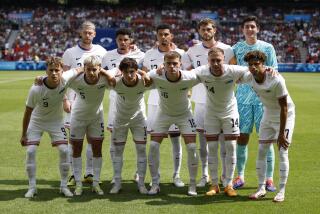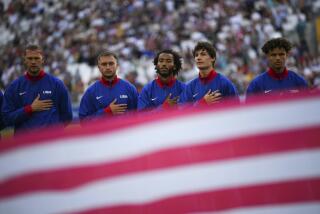A Peerless Primer
- Share via
For Asia, it is confirmation that, at last, it is ready for the big leagues.
For Japan and South Korea, it is a chance to out-promote, out-accommodate, out-sell and out-host one another, with the rest of the world watching, for 31 hyper-kinetic, hyper-competitive days.
For France, it is the opportunity to become the first team since Brazil in 1962 to repeat as soccer’s world champions.
For the United States, it is a grand experiment in sleep deprivation and/or VCR dependability, with most games kicking off locally some time between Conan O’Brien’s last joke and the first shriek of the morning alarm clock.
For millions across the planet, it is time to start brushing up on Saudi Arabian strikers, Mexican midfielders, Danish defenders and German goalkeepers, because the world’s biggest sporting spectacle kicks off in four days, defending champion France against newcomer Senegal, in Seoul.
In an effort to aid the cause, here are 20 things you should know about the 2002 World Cup, which begins Friday:
1. THE FORMAT
Thirty-two teams--16 in Japan, 16 in South Korea--divided into eight round-robin groups of four teams. (South Korea gets Groups A, B, C and D, Japan gets E, F, G and H.) Top two teams in each group advance to the second round, where the single-elimination phase of the tournament begins. Because South Korea got the opener, Japan will play host to the final--June 30 at Yokohama.
2. THE GROUPS
Group A: Defending champion France and three teams playing for second. Denmark reached the quarterfinals in 1998, Uruguay is back after a 12-year absence and tiny Senegal is making its World Cup debut.
Group B: Spain and Paraguay are paired in the same group again, an ominous sign for the Spaniards. In 1998, Spain, harboring title aspirations, finished third in its group behind Nigeria and Paraguay. Slovenia is a World Cup first-timer and South Africa, in its second go-round, looks to win its first game in a World Cup.
Group C: A gift from the “soccer gods” for Brazil, that’s how Pele put it. Brazil, which struggled to qualify, should have little trouble finishing first in a group that includes World Cup rookie China, injury-ridden Costa Rica and Turkey, back in the tournament for the first time since 1954.
Group D: The United States tries to better its 1998 performance, which shouldn’t be difficult; the Americans were a dead-last 32nd in France four years ago. Team USA faces its sternest test first, opening against Portugal, a potential semifinalist. After that, the Americans play South Korea, with second place in the group probably coming down to the U.S.-Poland match June 14.
Group E: Germany represents the past, Cameroon the future and Ireland is an experiment in what can happen when your coach fires your team captain--in Ireland’s case, fiery midfielder Roy Keane--barely a week before the World Cup opener. Saudi Arabia fills out the foursome.
Group F: The group of death, with four teams capable of winning other groups--Argentina, England, Sweden and Nigeria--crammed into the same quartet. Two will advance, two will shake their heads every time they look at Group H.
Group G: Italy, which finished second in 1994, and Croatia, third in 1998, seek to protect their turf against Mexico and debutante Ecuador. Second place behind Italy could be decided early; Mexico opens against Croatia on June 3.
Group H. The group of dearth, also known as Belgium, Japan, Russia and Tunisia. None of these teams are ranked among the top 22 in the world, yet two of them will advance to the round of 16. It’s in the rules.
3. BEST TEAM
France. Since winning the trophy four years ago, France has added the 2000 European championship and a cast of forwards (Thierry Henry, David Trezeguet, Sylvain Wiltord) who know how to put the ball in the net, which is more than the champions of 1998 could say.
4. WORST TEAM
Tunisia. After watching his team fail to score in the African Nations Cup in January, Coach Henri Michel bailed, leaving his players with these inspirational words: “We have weaknesses everywhere--tactically, technically, mentally, physically.”
5. PROBABLE FINAL FOUR
Three teams--France, Argentina and Italy--have the talent, the pedigree, the coaching and the karma to win the tournament. Argentina has so much skill up front that even with its three-forward alignment, Gabriel Batistuta, one of the top goal-producers on the planet, might not crack the starting 11. Italy has a potent three-headed strike force of its own--Francesco Totti, Christian Vieri and Alessandro Del Piero. With any amount of luck, Coach Giovanni Trapattoni might even permit them to shoot.
France and Argentina are set to meet in one semifinal. Italy’s savvy defense and favorable draw should send the Squadra Azzurra into the other semifinal against the winner of an all-Iberian quarterfinal, Spain-Portugal. Portugal hasn’t been to the World Cup since 1986, but Spain has, and we’re too familiar with that sad story. Give it to Portugal.
6. TEAM TO WATCH
Cameroon. The Indomitable Lions are reigning African and Olympic champions, with enough attacking talent to become the first African team to reach a World Cup final. One problem: If Cameroon wins its group, it is set to face Italy in the quarterfinals. If the Lions take second, they’d probably get Spain, Portugal and Italy in their next three games.
7. BEST FIRST-ROUND MATCHUP
Argentina-England, June 7 at Sapporo. Argentina eliminated England in 1986 on Diego Maradona’s infamous “Hand of God” goal. Argentina eliminated England in 1998 on penalty kicks. A player from Argentina, Pedro Duscher, broke the foot of English star David Beckham with a hard tackle during a club match in April. Falklands IV, as some have dubbed it.
8. BEST PLAYER
Zinedine Zidane, France. As his spectacular winning volley for Real Madrid in the Champions League final again demonstrated, Zidane rises to the big moment like no one else in the sport. In 1998, his dribbling and playmaking assisted France to the final--and then, Zidane took it from there, heading in two goals in a 3-0 upset of Brazil. However, Zidane injured his leg and asked to be removed during an exhibition Sunday against South Korea.
9. COMEBACK PLAYER
Ronaldo, Brazil. His disappearing act in the 1998 final was merely the least of it. Ronaldo, twice FIFA world player of the year, lost three years to knee injuries and surgeries before returning to Internazionale’s lineup late in the just-completed Italian League season. If he’s fit and in form, Brazil is a different team, making this an altogether different tournament.
10. COMEBACK COACH
Hernan Dario Gomez, Ecuador. Barely a year ago, Gomez was pistol-whipped and shot in the leg by a group of attackers allegedly angered by Gomez’ decision to leave the son of former Ecuadorian president Abdal Bucaram off the national under-20 team. Gomez briefly resigned before a nationwide show of support persuaded him to return. From there, Gomez finished guiding Ecuador to its first World Cup appearance.
11. COACH TO WATCH
Bora Milutinovic, China. After taking Mexico, Costa Rica, the United States and Nigeria to the second round of the last four World Cups, Bora tries to make it five for five with his biggest challenge yet.
12. GOALKEEPERS TO WATCH
Fabien Barthez of France is an obvious choice, because he’s capable of being the best keeper in the tournament and the worst keeper in the tournament--sometimes both in the same half. Jose Luis Chilavert of Paraguay is the Charles Barkley of international soccer--always quick with an outrageous opinion, and currently serving a one-game suspension for spitting in the face of Roberto Carlos. Oliver Kahn of Germany and Gianluigi Buffon of Italy are two of the most dependable shot stoppers in Europe.
13. GOALKEEPERS TO WATCH AFTER U.S. COACH BRUCE ARENA TELLS ONE OF THEM HE HAS TO SIT
Tissue-thin at most positions, the United States has two keepers capable of starting, and expecting to start, which makes either Kasey Keller or Brad Friedel the leading candidate for Most Disgruntled American at the World Cup. At least until the Portugal game is finished.
14. FORWARDS TO WATCH
Michael Owen of England fulfilled the promise that his scintillating strike against Argentina four years ago suggested; he was selected European player of the year after leading Liverpool to the English League Cup, F.A. Cup and UEFA Cup in 2001. Henry made a similar mark with Arsenal this season, leading the Gunners to the English Premier League and F.A. Cup titles. Patrick Mboma of Cameroon tries to take his country further than any African nation has gone in a World Cup. Raul of Spain gets his last chance to turn reputation into production in a major tournament.
15. MIDFIELDERS TO WATCH
Luis Figo of Portugal, Zidane’s teammate at Real Madrid, was FIFA’s world player of the year in 2001, but he comes to the World Cup with a bad ankle. Manchester United teammates Beckham and Argentina’s Juan Sebastian Veron have never had an intrasquad scrimmage quite like the one scheduled for June 7 at Sapporo. Patrick Vieira of France is an important defensive shield, the man in the middle who has Zidane’s back.
16. DEFENDERS TO WATCH
In this World Cup, they come in tandems. Lilian Thuram and Marcel Desailly of France, and Paolo Maldini and Alessandro Nesta of Italy are the keys to the best two backlines in the tournament. Carlos Gamarra and Celso Ayala of Paraguay are not as celebrated, but in 1998 they anchored a defense that gave up only two goals in 383 minutes. Brazil’s Roberto Carlos is not really a defender in the traditional sense--more a fullback-forward hybrid who seems to be drawn to the opposition goalposts like an overdeveloped magnet.
17. DEFENDERS TO WATCH THROUGH THE FINGERS OF THE SWEATY PALMS PLASTERED ACROSS YOUR NERVE-RACKED FACE
The U.S. backline, which is too slow in the middle, too tentative on the outside and the reason goalkeepers Keller and Friedel have lost most of their hair. A thrill a minute, this bunch. Figo and Portugal can hardly wait.
18. STADIUM TO WATCH
The brand-new Sapporo Dome features a grass field that soaks up sunshine outside on most days, then is wheeled inside on a “hovering stage” for games. More fun to watch than Belgium-Tunisia.
19. BEST U.S. PLAYER
Clint Mathis. Yes, that’s him on the cover of Sports Illustrated. A male American soccer player on the cover of Sports Illustrated. A male American soccer player who scores important goals for the national team and is now wanted by some of the biggest clubs in Europe. And to think the Galaxy shipped him to New Jersey to make room for Luis Hernandez.
20. BEST-CASE SCENARIO FOR TEAM USA
Keller starts against Portugal and saves everything knocked his way, save one, holding the final result to 1-0. Confidence buoyed, the Americans get two goals from Mathis to beat South Korea, then close out the group with a 1-1 tie with Poland. Team USA advances on goal differential, meets Italy in the second round, begins preparations for Germany 2006.
More to Read
Go beyond the scoreboard
Get the latest on L.A.'s teams in the daily Sports Report newsletter.
You may occasionally receive promotional content from the Los Angeles Times.






